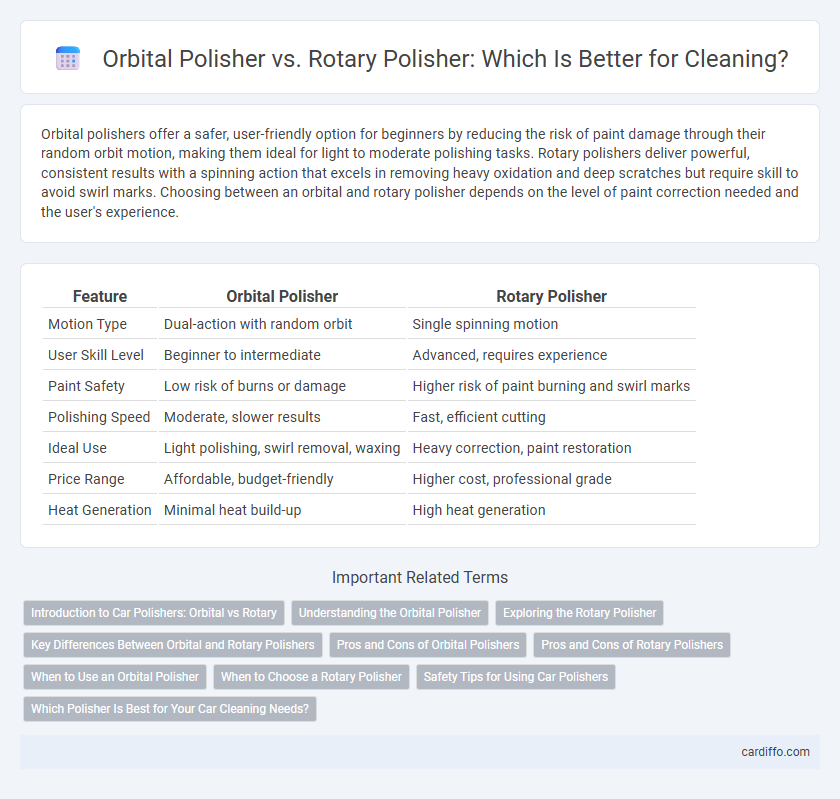Orbital polishers offer a safer, user-friendly option for beginners by reducing the risk of paint damage through their random orbit motion, making them ideal for light to moderate polishing tasks. Rotary polishers deliver powerful, consistent results with a spinning action that excels in removing heavy oxidation and deep scratches but require skill to avoid swirl marks. Choosing between an orbital and rotary polisher depends on the level of paint correction needed and the user's experience.
Table of Comparison
| Feature | Orbital Polisher | Rotary Polisher |
|---|---|---|
| Motion Type | Dual-action with random orbit | Single spinning motion |
| User Skill Level | Beginner to intermediate | Advanced, requires experience |
| Paint Safety | Low risk of burns or damage | Higher risk of paint burning and swirl marks |
| Polishing Speed | Moderate, slower results | Fast, efficient cutting |
| Ideal Use | Light polishing, swirl removal, waxing | Heavy correction, paint restoration |
| Price Range | Affordable, budget-friendly | Higher cost, professional grade |
| Heat Generation | Minimal heat build-up | High heat generation |
Introduction to Car Polishers: Orbital vs Rotary
Orbital polishers use a dual-action motion combining rotation and oscillation, reducing heat buildup and minimizing the risk of paint damage, making them ideal for beginners and delicate finishes. Rotary polishers generate a consistent circular motion with higher speed and greater cutting power, enabling effective removal of deep scratches and oxidation but requiring more skill to avoid swirl marks. Choosing between orbital and rotary polishers depends on the user's experience level and the specific restoration or detailing needs of the vehicle.
Understanding the Orbital Polisher
An orbital polisher operates with a dual-action mechanism that combines oscillating and rotating movements, reducing the risk of paint damage compared to traditional rotary polishers. This machine offers greater control and is ideal for beginners or for delicate surfaces, as it minimizes swirl marks and heat buildup. Its versatility makes it suitable for a variety of cleaning and polishing tasks, enhancing the finish quality on automotive paint, glass, and other surfaces.
Exploring the Rotary Polisher
Rotary polishers offer high-speed rotation that effectively removes deep scratches and oxidation from surfaces, making them ideal for heavy-duty paint correction tasks. Their consistent torque and powerful motor provide enhanced control and precision, especially on flat surfaces and large areas. While requiring careful handling to avoid swirl marks, rotary polishers deliver professional-grade results when used with appropriate pads and polishing compounds.
Key Differences Between Orbital and Rotary Polishers
Orbital polishers feature a dual-action mechanism that moves the pad in both oscillating and circular motions, reducing the risk of paint damage and swirl marks, making them ideal for beginners and delicate surfaces. Rotary polishers rotate the pad in a single, consistent circular motion, offering more aggressive cutting power suitable for removing deep scratches and heavy oxidation but require more skill to avoid holograms and burns. The main differences lie in their motion patterns, level of cutting efficiency, and user-friendliness, with orbital polishers providing safety and versatility, while rotary polishers deliver superior correction results with higher risk.
Pros and Cons of Orbital Polishers
Orbital polishers offer greater control and reduced risk of paint damage compared to rotary polishers, making them ideal for beginners and delicate surfaces. Their random orbital motion prevents swirl marks while providing consistent polishing results, though they may require more time and effort for heavy correction tasks. However, orbital polishers typically generate less heat, minimizing the chance of burning the paint but limiting their effectiveness on deeply scratched or severely oxidized surfaces.
Pros and Cons of Rotary Polishers
Rotary polishers deliver high-speed rotation ideal for removing heavy oxidation and deep scratches, making them effective for restoring severely damaged surfaces. Their main disadvantage is the increased risk of paint burns and swirl marks due to continuous 360-degree movement, requiring skilled handling to avoid damaging the finish. While rotary polishers excel in power and efficiency, they demand precision and experience, contrasting with the user-friendly design of orbital polishers.
When to Use an Orbital Polisher
An orbital polisher is ideal for beginners and delicate surfaces because it reduces the risk of swirl marks and burns by using a random orbital motion. It excels in maintaining paint finishes on cars, boats, and motorcycles while ensuring even polishing without aggressive abrasion. Choose an orbital polisher when precision and safety are paramount, especially on oxidized or lightly scratched surfaces requiring gentle correction.
When to Choose a Rotary Polisher
Choose a rotary polisher for heavy-duty cleaning tasks that require aggressive paint correction or removal of deep scratches and oxidation. Its powerful, consistent spinning motion is ideal for professionals seeking high efficiency on hard, durable surfaces. Rotary polishers excel in automotive detailing when precision and speed outweigh the risk of potential swirl marks.
Safety Tips for Using Car Polishers
When using orbital polishers, ensure to wear protective gloves and goggles to prevent skin irritation and eye injury from polish splatter. Rotary polishers generate higher heat, so use slower speeds to avoid paint burning and always keep the tool moving to prevent damage. Proper ventilation and regular breaks help reduce inhalation of harmful polishing fumes for both types of polishers.
Which Polisher Is Best for Your Car Cleaning Needs?
Orbital polishers offer a safer option for car cleaning with less risk of paint damage due to their random orbital motion, making them ideal for beginners and detailed work. Rotary polishers deliver more power and faster correction of deep scratches but require experienced handling to avoid swirl marks and clear coat burns. Choosing the best polisher depends on your car's paint condition, skill level, and the desired finish quality.
Orbital polisher vs Rotary polisher Infographic

 cardiffo.com
cardiffo.com